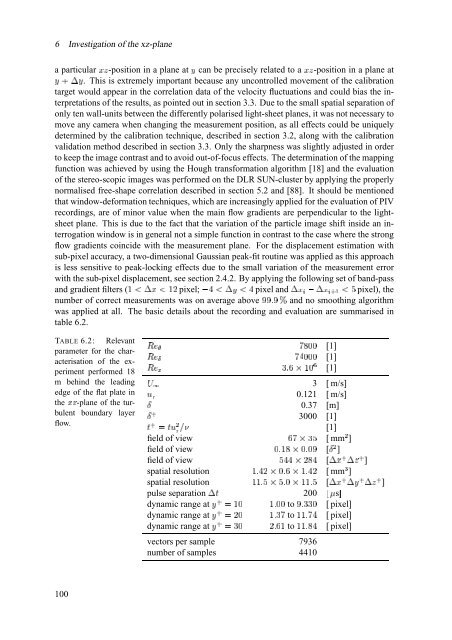The significance of coherent flow structures for the turbulent mixing ...
The significance of coherent flow structures for the turbulent mixing ...
The significance of coherent flow structures for the turbulent mixing ...
Create successful ePaper yourself
Turn your PDF publications into a flip-book with our unique Google optimized e-Paper software.
M<br />
M<br />
^<br />
^<br />
^<br />
g<br />
h<br />
h<br />
þ<br />
<br />
Æ<br />
M<br />
Ó<br />
<br />
Ó<br />
Ó<br />
*<br />
T<br />
<br />
S<br />
c<br />
`<br />
`<br />
<br />
<br />
<br />
M<br />
Æ<br />
M<br />
M<br />
¨<br />
M<br />
6 Investigation <strong>of</strong> <strong>the</strong> xz-plane<br />
a particular á9X -position in a plane at Ä can be precisely related to a á9X -position in a plane at<br />
Ä . This is extremely important because any uncontrolled movement <strong>of</strong> <strong>the</strong> calibration<br />
ÄZY<br />
target would appear in <strong>the</strong> correlation data <strong>of</strong> <strong>the</strong> velocity fluctuations and could bias <strong>the</strong> interpretations<br />
<strong>of</strong> <strong>the</strong> results, as pointed out in section 3.3. Due to <strong>the</strong> small spatial separation <strong>of</strong><br />
only ten wall-units between <strong>the</strong> differently polarised light-sheet planes, it was not necessary to<br />
move any camera when changing <strong>the</strong> measurement position, as all effects could be uniquely<br />
determined by <strong>the</strong> calibration technique, described in section 3.2, along with <strong>the</strong> calibration<br />
validation method described in section 3.3. Only <strong>the</strong> sharpness was slightly adjusted in order<br />
to keep <strong>the</strong> image contrast and to avoid out-<strong>of</strong>-focus effects. <strong>The</strong> determination <strong>of</strong> <strong>the</strong> mapping<br />
function was achieved by using <strong>the</strong> Hough trans<strong>for</strong>mation algorithm [18] and <strong>the</strong> evaluation<br />
<strong>of</strong> <strong>the</strong> stereo-scopic images was per<strong>for</strong>med on <strong>the</strong> DLR SUN-cluster by applying <strong>the</strong> properly<br />
normalised free-shape correlation described in section 5.2 and [88]. It should be mentioned<br />
that window-de<strong>for</strong>mation techniques, which are increasingly applied <strong>for</strong> <strong>the</strong> evaluation <strong>of</strong> PIV<br />
recordings, are <strong>of</strong> minor value when <strong>the</strong> main <strong>flow</strong> gradients are perpendicular to <strong>the</strong> lightsheet<br />
plane. This is due to <strong>the</strong> fact that <strong>the</strong> variation <strong>of</strong> <strong>the</strong> particle image shift inside an interrogation<br />
window is in general not a simple function in contrast to <strong>the</strong> case where <strong>the</strong> strong<br />
<strong>flow</strong> gradients coincide with <strong>the</strong> measurement plane. For <strong>the</strong> displacement estimation with<br />
sub-pixel accuracy, a two-dimensional Gaussian peak-fit routine was applied as this approach<br />
is less sensitive to peak-locking effects due to <strong>the</strong> small variation <strong>of</strong> <strong>the</strong> measurement error<br />
with <strong>the</strong> sub-pixel displacement, see section 2.4.2. By applying <strong>the</strong> following set <strong>of</strong> band-pass<br />
and gradient filters ( Æ áJÆ Ó pixel; Î ÄXÆ pixel and M á[HÎ á[<br />
Å]\<br />
pixel), <strong>the</strong><br />
number <strong>of</strong> correct measurements was on average above þ and no smoothing algorithm<br />
T¢T<br />
was applied at all. <strong>The</strong> basic details about <strong>the</strong> recording and evaluation are summarised in<br />
table 6.2.<br />
TABLE 6.2: Relevant<br />
parameter <strong>for</strong> <strong>the</strong> characterisation<br />
<strong>of</strong> <strong>the</strong> experiment<br />
per<strong>for</strong>med 18<br />
m behind <strong>the</strong> leading<br />
edge <strong>of</strong> <strong>the</strong> flat plate in<br />
Ú.Q <strong>the</strong> -plane <strong>of</strong> <strong>the</strong> <strong>turbulent</strong><br />
boundary layer<br />
<strong>flow</strong>.<br />
×¥_<br />
×¥a<br />
×b<br />
*:ced<br />
¢<br />
¢ ¢ ¢<br />
`S<br />
þ¡ f<br />
[1]<br />
[1]<br />
[1]<br />
Ô 3 [ m/s]<br />
0.121 [ m/s]<br />
0.37 [m]<br />
3000 [1]<br />
[1]<br />
field <strong>of</strong> view<br />
field <strong>of</strong> view<br />
field <strong>of</strong> view<br />
spatial resolution<br />
spatial resolution<br />
Å W<br />
6 '<br />
þ*:<br />
*“þ<br />
¨k¢ld<br />
.*+ced dj<br />
ed þzþ¢*o¨5dp¨3*+<br />
dj¨<br />
*: dN<br />
[ mm' ]<br />
[Ö ' ] T<br />
[ M á Å ÓS<br />
þ¢*m<br />
þŒþ*o¨<br />
[ M á Å<br />
Ó [ mmn ]<br />
X΁ ]<br />
Ä4Å<br />
X΁ ]<br />
h<br />
pulse separation<br />
dynamic range M W ÄHÅ at<br />
dynamic ÄHÅ W range at<br />
dynamic ÄHÅ W range at<br />
þ¢*: ¢ þ¡<br />
þ¢*:<br />
¢<br />
*:c4þ<br />
to T<br />
to þŒþ¢* ` `<br />
to S<br />
þŒþ¢*<br />
200 qr ss<br />
*:¢¢<br />
[ pixel]<br />
[ pixel]<br />
[ pixel]<br />
vectors per sample 7936<br />
number <strong>of</strong> samples 4410<br />
100
















